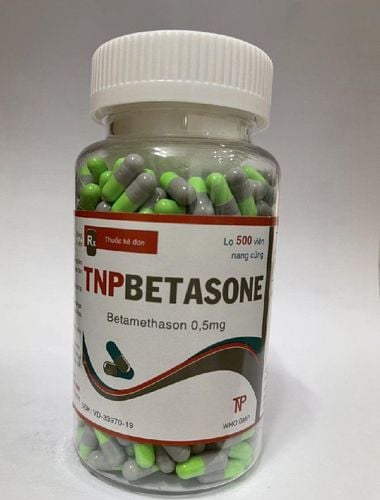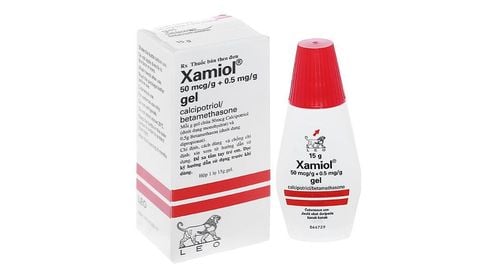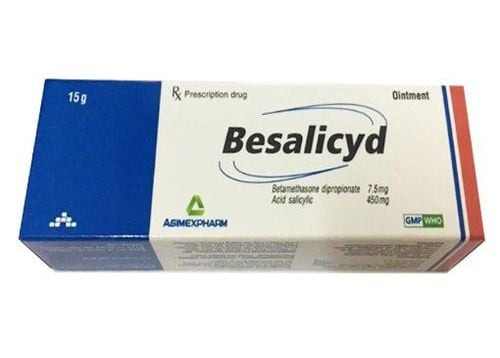This is an automatically translated article.
Psocabet is produced by Ha Tay Pharmaceutical Joint Stock Company. Psocabet has the main ingredients Calcipotriol and Betamethasone, indicated for the treatment of psoriasis. Complying with indications and doses of Psocabet will help patients improve treatment efficiency and ensure safety for health.
1. What is Psocabet?
Pocabet is classified in the group of drugs for the treatment of dermatological diseases, with the main active ingredients being Calcipotriol and Betamethasone.Dosage form: Skin ointment.
Packing form: 15g tube. Each tube contains 0.75mg Calcipotriol; 7.5mg Betamethasone and excipients just enough.
2. What are the effects of Psocabet?
Pharmacodynamics:
Calcipotriol is a derivative of vitamin D, which has the effect of differentiating and preventing the proliferation of keratinocytes. Thus, in psoriasis patients, Calcipotriol normalizes cell proliferation and differentiation. Betamethasone has anti-inflammatory, vasodilator, antipruritic, immunosuppressive properties. Betamethasone's anti-inflammatory mechanism has not been well studied. Pharmacokinetics:
Absorption: When applied to normal skin, systemic absorption of Psocabet is less than 1%. When applied to psoriatic skin and covered with a bandage, it may increase local absorption of the drug. Distribution: studies in rats have shown that Psocabet has the highest concentrations in the liver and kidneys. Metabolism: Psocabet is rapidly and completely metabolised by the systemic route. The liver is the major site of betamethasone metabolism. Elimination: The half-life when applied topically is prolonged by several days due to residual drug on the skin. Calcipotriol is eliminated mainly in the faeces, Bethamethasone is eliminated mainly in the urine.
3. Indications and contraindications of the drug Psocabet
Psocabet is indicated in the treatment of membranous psoriasis in adults, mild to moderate severity.
Absolutely do not use Psocabet in the following cases:
Allergy to any ingredient of Psocabet; Exfoliative psoriasis, pustular psoriasis causing skin redness; Patients with calcium metabolism disorders; Viral skin lesions (Varicella, Herpes); Skin diseases caused by fungi, bacteria, parasites; Lesions on the skin due to tuberculosis, skin atrophy, stretch marks, rosacea, ulcers, wounds,...
4. Dosage and how to use the drug
Dosage:
Adults: Apply 1-2 times a day to the damaged skin. Use up to 100g/week and not more than 4 weeks; Patients with liver and kidney failure: There is not enough evidence on the safety of Psocabet when used in patients with liver or kidney failure; Children: Safety and efficacy have not been evaluated in children under 18 years of age. How to use:
Gently wash the damaged skin; Apply a thin layer of medicine to the damaged skin, gently rub it for good absorption; Do not shower after applying the medicine. Missing a dose of Psocabet :
Apply the medicine as soon as you remember. Do not apply a double dose to make up for a missed dose. Overdosage of Psocabet:
Symptoms of overdose have been recorded including: Hypercalcemia with manifestations of constipation, polyuria, muscle weakness, confusion, coma. Prolonged use of topical P socabet causes secondary adrenal insufficiency (due to suppression of pituitary-adrenal function), but is reversible. Treatment: In chronic poisoning, the drug must be stopped immediately and taken to the nearest medical facility for proper diagnosis and treatment.
5. Undesirable effects
In the process of using Psocabet, you may encounter unwanted effects such as:
Common: Skin peeling, itching,...; Uncommon: Folliculitis; skin infections caused by fungi, viruses, bacteria; skin atrophy, dermatitis, erythema, burning sensation, purpura, ecchymosis, worsening of psoriasis, change in skin color, pain in the application area,...; Rare: Hypersensitivity, boils, hypercalcemia, pustular psoriasis, appearance of wrinkles, photosensitivity, acne, dry skin,... The side effects listed above are not exhaustive. You may also experience other unusual symptoms while taking the drug. Therefore, immediately notify your doctor when any symptoms appear during the course of taking the drug for advice and prompt treatment.
6. Some notes when using the drug Psocabet
Pregnant women: Animal studies have shown that corticosteroids have the potential to cause reproductive toxicity. However, several epidemiological studies in more than 300 pregnant women using corticosteroids during pregnancy have not revealed birth defects in the infant. Therefore, it is necessary to weigh the benefits of treatment for the mother and the risks to the fetus when using Psocabet during pregnancy. Lactation: Betamethasone is excreted in human milk. Therefore, it should be used with caution and instructed the mother not to apply the drug to the breast. Psocabet has no significant influence on the ability to drive and use machines. Use caution when combined with other steroids. Psocabet can increase blood calcium if taken in excess of the maximum dose. Therefore, absolutely adhere to the treatment and do not apply more than 30% of the skin surface. Do not use on face and genitals. Do not use when the drug shows signs of changing properties, color or no longer has the seal.
7. Preservation of drugs
Store Psocabet in sealed packaging, in a cool, dry place, below 30 degrees Celsius. Keep this medicine out of reach of children and pets. Above is information about the effects of Psocabet, dosage and notes when using. To ensure safety for your health and maximize the effectiveness of your treatment, you need to take Psocabet exactly as directed by your doctor.
Please dial HOTLINE for more information or register for an appointment HERE. Download MyVinmec app to make appointments faster and to manage your bookings easily.













